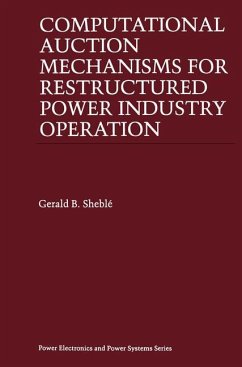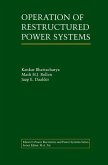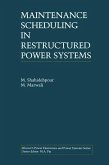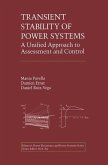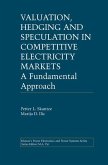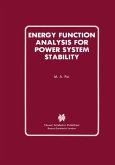`Electric energy must be treated as a commodity which can be bought, sold, and traded, taking into account its time- and space-varying values and costs.` Spot Pricing of Electricity, Schweppe et al, 1988.
Computational Auction Mechanisms for Restructured Power Industry Operation outlines the application of auction methods for all aspects of power system operation, primarily for a competitive environment. A complete description of the industry structure as well as the various markets now being formed is given. A thorough introduction to auction basics is included to explain how auctions have grown in other industries. Auction methods are compared to classical techniques for power system analysis, operations, and planning. The traditional applications of economic dispatch, optimal power flow and unit commitment are compared to auction mechanisms. Algorithms for auctions using linearized power flow equations, DC power flow equations, and AC power flow equations are included. The bundling of supportive services, known as ancillary services within the United States, is discussed. Extensions to the basic auction algorithms for inclusion of supportive services as well as algorithms for scheduling and bidding on generation for GENCOs or independent power producers are presented. Algorithms for scheduling and contracting with customers are also presented for energy service companies. An introduction to the various commodity and financial market products includes the use of futures and options for GENCOs. The material is useful for students performing research on the new business environment based on competition. Regulators will find information on initial methods of designing and evaluating market systems, and power exchange and financial analysts will find information on the interdependence of markets and power system-based techniques for risk management. This information compares the new business environment solutions with old business environment solutions.
Computational Auction Mechanisms for Restructured Power Industry Operation provides a first introduction to how electricity will be traded as a commodity in the future.
Hinweis: Dieser Artikel kann nur an eine deutsche Lieferadresse ausgeliefert werden.
Computational Auction Mechanisms for Restructured Power Industry Operation outlines the application of auction methods for all aspects of power system operation, primarily for a competitive environment. A complete description of the industry structure as well as the various markets now being formed is given. A thorough introduction to auction basics is included to explain how auctions have grown in other industries. Auction methods are compared to classical techniques for power system analysis, operations, and planning. The traditional applications of economic dispatch, optimal power flow and unit commitment are compared to auction mechanisms. Algorithms for auctions using linearized power flow equations, DC power flow equations, and AC power flow equations are included. The bundling of supportive services, known as ancillary services within the United States, is discussed. Extensions to the basic auction algorithms for inclusion of supportive services as well as algorithms for scheduling and bidding on generation for GENCOs or independent power producers are presented. Algorithms for scheduling and contracting with customers are also presented for energy service companies. An introduction to the various commodity and financial market products includes the use of futures and options for GENCOs. The material is useful for students performing research on the new business environment based on competition. Regulators will find information on initial methods of designing and evaluating market systems, and power exchange and financial analysts will find information on the interdependence of markets and power system-based techniques for risk management. This information compares the new business environment solutions with old business environment solutions.
Computational Auction Mechanisms for Restructured Power Industry Operation provides a first introduction to how electricity will be traded as a commodity in the future.
Hinweis: Dieser Artikel kann nur an eine deutsche Lieferadresse ausgeliefert werden.

